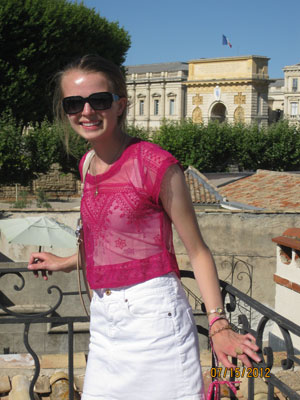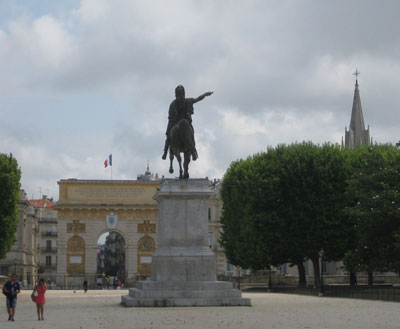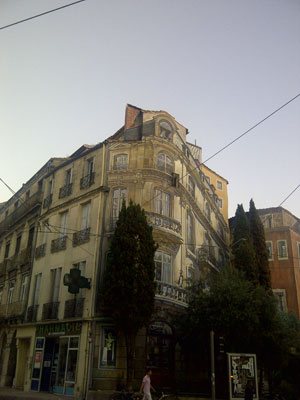Experiencing the joys of French living on a 4-week immersion program in Montpellier
This article appears on page 38 of the August 2014 issue.
Claudia Dantoin; Mequon, Wi
Many times, it is difficult for the younger generation to travel independently of family tours or large cruises. However, I found one company that specifically caters to the high school and younger crowd (I was 16), offering experiences focused on education with an international flair. The Oxbridge Academic Programs (New York, NY; 800/828-8349) offer a wide variety of 4-week-long programs in England, France and Spain that allows students (grades 8 to 12) to experience the joys of authentic international travel.
The program
While many programs are offered, I chose L’Académie de France, a 100%-French-immersion program located in the beautiful medieval town of Montpellier, for my July 2012 solo journey.
In order to join the group of roughly 80 or so students from around the world, I had to complete a questionnaire in both English and French designed to gauge prospective students’ language backgrounds.
The cost for the month-long stay in Montpellier, including all tours, breakfasts, dinners, classes, field trips and activities, was $7,695, excluding international airfare and lunches. I think this was a bargain; the program was phenomenal!
Getting there
Located at the midpoint of France’s Mediterranean coast, Montpellier is relatively remote and not often on a traveler’s radar. My July 4th Air France flights involved connections in Milwaukee, Detroit and Paris before I continued on to Montpellier. As my Detroit-to-Paris flight took off, I had a stunning view of the July 4th fireworks from 10,000 feet. What an auspicious beginning!
Upon my arrival in Paris, I hit my first snag as an inexperienced independent traveler in trying to find a domestic gate from the international terminal. Charles de Gaulle Airport was hardly the best place for a first-timer like me.
While my connection was tight, I eventually found the gate as well as two staff members from Oxbridge, Emilie and César, who greeted me with large smiles. Upon arriving at Montpellier’s airport, I discovered that my luggage hadn’t been as lucky as I was in making my flight; it was sitting back in Paris. However, Air France handled the matter well, and César promised that someone would come back later to pick up my luggage (which all happened without a wrinkle). Overall, success! My first solo international flight was completed.
Accommodations
One of the main reasons I felt like a local during my time in Montpellier, despite being part of an international program, was the accommodations. Located within a 5-minute walk of the medieval portion of town and nestled amongst churches, pharmacies and delightful hôtels particuliers, le Lycée Notre Dame de la Merci, a small Catholic boarding high school, became our home.
Most students had single rooms. While not palatial and certainly not air-conditioned (which might have been a problem without the fan I ended up purchasing), each room came with a desk, a bed, a closet and a sink. The bathrooms were communal, in the style of a college dorm.
Despite the austere description, I loved the rooms, as they all had large shutters that opened up to a courtyard. My second-floor room even had a ledge that I converted into a window seat, where I could sit and watch people walking around below.
While there was no WiFi, there were computers available if students wanted to use the Internet (and experience the joys of learning how to type on a French keyboard).
The classes
From the first day, objective number one was immersion. Regardless of skill level, all students were expected to speak in French. Over the course of our month, all of the tours we took were in French.
All classes above the grammar-based courses (for those with less proficiency in the language) were taught in French. If a student were heard speaking any other language, the staff upheld a system of “action, reaction,” whereupon the student would typically have to conjugate an irregular verb. Quelle horreur!
Each student chose two classes: one “major” that met six days a week and one “minor” that met three times a week. For those with less background in French, their major was a predetermined grammar-based course. The other levels offered a wide variety of options from the arts, history, science and more.
For my major, I chose L’Histoire et Culture Française (French History and Culture), and for my minor I chose les Arts Plastiques (Visual Arts). Both courses were fabulous!
My history professor, Rémi, was a filmmaker who had concentrated on the culture of France in his studies. My arts professor was a full-time visual artist with her own studio.
All of the classes were intended to give students a taste of each subject from a French perspective and introduce them to French life through that lens.
My visual arts class often included field trips to different galleries, exhibitions and museums.
In my history class, we learned about the French Revolution, then attended a Bastille Day parade, noting the fascinating differences with America’s Independence Day festivities in the process.
Activities
The city of Montpellier offered a wide range of activities, and we always had something to do, including exploring the various quartiers, the magnificent churches (I highly recommend le Cathédrale de Montpellier), le Faculté de Médecine (the oldest medical school still in operation in the Western Hemisphere) and the famous Parc de Peyrou and main square, la Place de la Comédie.
The mall, Polygone, was a particular draw during the hottest days (it was about 30°C, or 86°F, throughout the month), as this was one of the few air-conditioned buildings in town.
For our lunch hour, we were able to search out our favorite cafés and truly live like locals. One of my favorite lunch spots was Yomi (16 rue Saint Guilhem), a chic bagel shop that also specialized in frozen yogurt.
All areas were incredibly safe, with many people walking around. As an added precaution, all students had to be back in the lycée by 11 p.m., though most were back before, and each time a student left or returned to the school, he or she had to sign out. This system worked well, and no one in the program that I spoke with ever felt unsafe.
During our free time, Oxbridge organized all sorts of activities. Crêpe making, a workshop in bandes dessinée (French comic strips) taught by actual comics artists, medieval calligraphy lessons and visits to museums (I saw the Caravaggio exhibit twice at the Musée Fabre) all were part of a normal afternoon.
At night, there was a variety of concerts and other entertainment. Carré Saint-Anne had everything from jazz to salsa, and every Friday in July there was a small street fair near place de la Comédie where vendors sold everything from authentic Moroccan kabobs to lavender soap.
Montpellier is also part of the Chemin de Saint Jacques de Compostelle (Way of St. James), and I saw his symbolic shell all over town. I actually took one afternoon to follow its windings through the Old Town.
Furthermore, Montpellier is home to seven major trompe l’oeil murals, some quite elaborate, that pop out from unexpected corners. I quite enjoyed discovering them on my daily walks with friends.
Outside the city
On Sundays, when the entire town was quiet, we all would shuttle off to the sea for a day of sun and relaxation at one of the various port towns nearby. On one memorable occasion, we took in a show at the famous Montpellier Opera.
We also traveled outside of the city to take in destinations such as Avignon, including the famous bridge and the Palace of the Popes, where we were provided with audio guides (programmed in French, of course); Nîmes, where we visited an art gallery and the coliseum; the famous aqueducts of Pont du Gard; La Grotte de Clamouse, an elaborate cave in the process of gaining UNESCO World Heritage distinction, and the charming village of St. Guilham le Désert, voted one of France’s most beautiful villages and home to a UNESCO World Heritage Site, the Abbey of Gellone — a town truly worth the visit.
With the whole group of 80 together for many of these excursions, we often would break off into smaller groups, creating manageable parties of five to ten people.
À la Fin
The rewards for those who took advantage of all that the program offered were astronomical. Being able to live and interact with another culture at any age is wonderful, but to experience that as a younger traveler is particularly meaningful. The immersion program, itself, was also an incredible success. Two weeks in, I had begun to dream in French. After three weeks, I was speaking without hesitation.
On one of my final days, when haggling with a shopkeeper, I mentioned that I could not come back, as I was going to America the next day. Being as friendly as she was shrewd, the proprietress promptly asked me if I was going there… on vacation.
My goal had been realized!
While the date of this trip is a bit beyond ITN’s cutoff date for Feature Articles, it was only recently received, as the author, at the time of her trip, was a minor and unsure if her article would be accepted for publication; she held onto it until she turned 18. Note: ITN does not have a minimum age requirement for article submissions. — Editor




